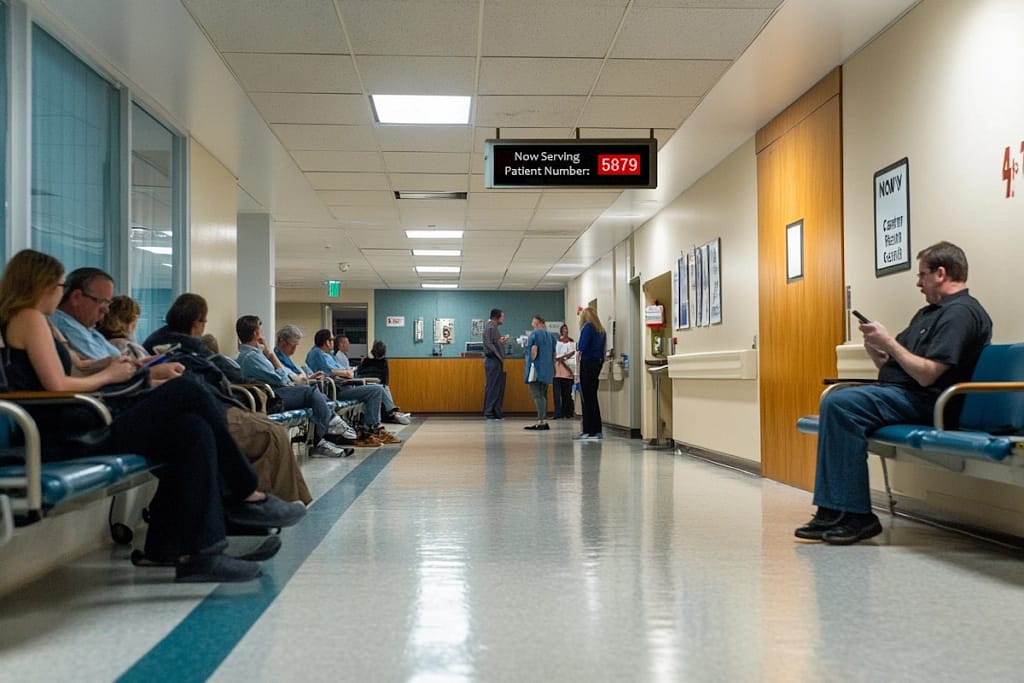Living With It: The Medical Industry’s New Approach to Managing Everything Except Health

In a world where medical science has made staggering advancements, curing diseases is now apparently passé. Gone are the days when patients would visit a doctor hoping for a resolution. Instead, a fresh approach to healthcare has emerged, one that focuses on helping people “live with it” rather than fixing the root problem. This new frontier of modern medicine—championed by hospitals, doctors, and insurance companies alike—is not about curing but about managing conditions long enough for your wallet to develop a chronic condition of its own.
The Birth of the “Live-With-It” Method: A Brief History of Non-Cures
For centuries, doctors took the outlandish view that a patient’s sickness was an issue that needed solving. Whether it was the bubonic plague, smallpox, or even a simple cold, physicians would doggedly work to cure people. What fools we were!
Fast forward to the modern era, where doctors and insurance companies have embraced the harsh reality: curing diseases is not sustainable—for profits. If we cured everything, patients would stop coming in. Who would need another prescription refill if that rash, indigestion, or chronic sniffle were miraculously cured once and for all?
Thus, the “Live-With-It” method was born, a progressive philosophy that says, “You’ve got a condition? Congratulations. Now let’s manage that for the rest of your natural life. Also, here’s a $1,200 bill for your 10-minute consult.”
As Dr. Benjamin Pillpusher, one of the pioneers of this brave new world, puts it: “Curing is a bit too final, don’t you think? We prefer to keep the patient in a sweet spot—sick enough to keep coming back but not so sick they can’t afford the co-pays.”
Hospitals: Where Cure is a Four-Letter Word
If you’ve been to a hospital lately, you might notice something peculiar: no one really talks about curing anything. From the moment you walk in, clutching your insurance card like a protective talisman, you’ll notice the careful wording from hospital staff. Terms like “long-term care plan,” “chronic management strategy,” and “lifestyle modification” fill the air as patients nod politely, hiding the confusion behind their medical bills.
Hospitals have truly embraced the art of managing conditions rather than solving them. It’s a delicate dance: stringing patients along just enough that they feel cared for, but not so much that they think they’ll ever fully recover. “Hope is a dangerous thing,” notes Linda Chaching, head of Patient Prolonged Care Services at the Mayo Bills Clinic. “We don’t want patients getting too optimistic. It’s better to give them just enough care to keep them coming back. Besides, who wants to miss out on another MRI? It’s basically the Netflix of medical imaging.”
Real-Life Testimonials:
Meet Greg Givitume, a 48-year-old man diagnosed with a chronic lower back condition. “I’ve been in and out of the hospital for five years now,” Greg says cheerfully. “Every time I go, they tell me to keep taking my meds, book another follow-up in six months, and see a specialist who tells me to keep doing exactly what I’ve been doing. It’s like Groundhog Day but with more Tylenol. And I’m still in pain, but I think I’m managing it. Or rather, it’s managing my bank account.”
Greg’s story is not unique. In fact, it’s become the hospital success story of our time: keeping patients in a state of perpetual care, or what industry insiders fondly refer to as the “Forever Revenue Stream.”
Doctors: Specialists in Non-Solutions
While hospitals have embraced the Live-With-It method, it’s the doctors who have truly refined the practice of providing everything except a solution. No longer are you burdened with the false hope that a single visit will set you on the path to health. Now, a doctor’s job is more about walking the fine line between a comforting bedside manner and a vague plan of inaction.
Take, for example, Dr. Sarah Keepemcoming, a rheumatologist known for her delicate hand in “treating” patients with autoimmune disorders. “My patients know I’m not here to cure them. I’m here to monitor their symptoms, adjust their medications, and keep track of how they’re coping with it all. Curing would only deprive them of this holistic relationship we’ve built around their monthly co-payments.”
One of her patients, a 32-year-old named Emma Wattsnext, has been seeing Dr. Keepemcoming for four years. Emma explains, “I go in, she smiles, she runs some tests, and then she tells me that I’m still sick. It’s nice to feel seen, even if I’m still dealing with joint pain 24/7. At least my doctor and I are in this together—well, sort of. She’s in it for the paycheck, and I’m in it for the sweet, sweet distraction from my empty savings account.”
Doctors are now armed with a veritable buffet of diagnostic tools designed not to solve problems but to keep you engaged. “What’s great about modern medicine is the sheer number of tests we can run!” Dr. Keepemcoming adds. “I can always tell my patients that more monitoring is needed. It keeps the hope alive—just enough to keep them paying—but never quite enough to result in a cure. It’s like being trapped in a beautiful medical limbo.”

Insurance Companies: The True Innovators of Sickness Management
Of course, none of this would be possible without the true masterminds behind the scenes: insurance companies. Long known for their groundbreaking work in denying claims while raising premiums, these giants have taken the Live-With-It methodology to new heights.
Let’s face it: who needs a cure when you have a health insurance plan? Insurance companies are experts in covering just enough to keep patients alive—but not alive enough to get better.
“It’s really quite simple,” says Gordon Heartless, CEO of Premium Health, one of the largest insurance companies in the country. “We don’t see patients as people in need of help. We see them as ongoing investments. And the best way to grow that investment is to ensure they live in a constant state of mild discomfort.”
Heartless has implemented a number of revolutionary changes to the industry. For example, his company now offers the “Perpetual Pain Plan,” which guarantees coverage for some medications, as long as you agree to never fully recover. “It’s a win-win,” Heartless explains. “The patient gets just enough care to keep them functioning, and we get a steady stream of premiums. Curing people is like throwing money in a black hole. Why would we ever do that?”
Under this model, insurance companies have become the gatekeepers of perpetual discomfort. They expertly juggle deductibles, coverage caps, and the fine print of co-insurance plans, ensuring that no patient ever gets too comfortable. It’s a delicate art, one that keeps the healthcare system afloat on a sea of unpaid claims and pre-existing condition exclusions.
Patient Story:
David Owmynee, a 54-year-old construction worker, has been dealing with chronic knee pain for the past decade. “I’ve been fighting with my insurance company for years,” he says. “They approve just enough treatments to keep me on my feet, but never enough to actually fix the problem. I like to think of it as a dance—except instead of dancing, I’m limping, and instead of music, it’s the sound of my bank account draining.”
David’s story highlights the crucial role insurance companies play in the Live-With-It method. As long as David can hobble into work, pay his premiums, and not cost the insurance company too much, he’s considered a success.
Cutting-Edge Treatments to Help You Cope
The medical industry isn’t just content with keeping patients in limbo. No, they’re innovators at heart, and the latest treatments are designed to help people live with their conditions in style. From the latest in symptom-suppressing pharmaceuticals to apps that remind you just how sick you still are, technology is playing a key role in managing—not curing—health.
Medication Roulette:
Pharmaceutical companies are also getting in on the action, with entire divisions now dedicated to what they call “maintenance drugs.” These are the drugs that don’t cure your ailment but help you “manage” it long enough to refill your prescription. “Our new line of meds is designed for maximum longevity,” explains Dr. Pharma Repsalot. “We’ve learned that a patient who is moderately sick but not dying is the ideal customer. They need our product, but they won’t stop needing it any time soon.”
Patients like Margaret Dalydoser, who has been on three different heart medications for the past 15 years, can attest to this. “I used to think they’d eventually fix me up,” she laughs. “Now I just hope they don’t run out of things for me to take. They’re keeping me alive in a state of expensive, never-ending ‘treatment.’ It’s almost like being a VIP customer at a fancy spa, except the spa is my pharmacy.”
Wearable Tech to Remind You How Sick You Are:
Technology is also playing a crucial role. Devices like FitBits, Apple Watches, and the new “Don’t Hold Your Breath-o-Meter” ensure patients stay hyper-aware of their conditions. “It’s all about staying engaged with your illness,” says Jerry Technofix, CEO of SymptomTrackers Inc. “People love metrics. They love knowing that they’re sick and exactly how sick they are. These devices allow them to track their every symptom in real-time, ensuring they never forget their condition for a single moment of peace. It’s healthcare in the 21st century, and we’re proud to keep people perpetually aware of how unhealthy they are.”
One of the newest tech trends is the “Health Spiral Tracker”, which gives users constant updates on how their symptoms are worsening. “It’s empowering!” says Jenna Gimimoore, an enthusiastic user who’s been managing her chronic fatigue for eight years. “Instead of getting bogged down in hope or recovery, I can watch my health slowly deteriorate right from my phone. It’s like an endless countdown timer, except the countdown is to the point where I’ll need even more medication!”
The Tracker comes with an app that not only logs symptoms but also sends motivational messages like, “Keep Going! You’re Only 47% Worse Than Last Month!” or “Think of How Much You’re Contributing to Our Economy by Staying Sick!”
Medical Marketing: Turning Chronic Conditions into Lifestyle Brands
To cement the Live-With-It method as a permanent fixture of modern healthcare, the industry has taken an ingenious marketing approach. Conditions that were once treated with a sense of urgency are now celebrated as part of a patient’s identity. From chronic back pain to anxiety to lifelong digestive issues, living with a medical condition is being rebranded as a trendy, even fashionable, lifestyle.
“The key to keeping people in this loop of ongoing care is to normalize it,” says Bev Pillmore, a marketing consultant for several pharmaceutical companies. “We don’t want people thinking there’s something wrong with having a chronic condition; we want them to own it. Slogans like ‘Embrace the Ache’ and ‘Own Your Illness’ have been huge hits.”
Even social media influencers are getting in on the action, creating hashtags like #ChronicAndChic and #SickAndStylish. “Living with a chronic condition doesn’t have to be depressing,” says Instagram influencer Taylor Inpayne. “It’s all about managing it with flair. I love showing off my latest medication cocktails and cozy doctor’s office OOTDs (Outfits of the Day).”
Taylor has become a household name among the chronically ill, with her followers eagerly awaiting her next post about the latest flare-up in her autoimmune disorder. “It’s like a fun surprise,” she says. “Will I get sicker? Will my medication work? The suspense keeps my followers engaged—and keeps me coming back for more appointments.”
Chronic Illness Merch:
For those looking to wear their conditions proudly, a booming industry of chronic illness merchandise has taken off. T-shirts that say “I Survived Another Co-Pay” and mugs with slogans like “Caffeine and Chronic Pain Are My Superpowers” have become best-sellers. “People want to feel connected to their illness,” explains Bev Pillmore. “It’s part of who they are now, and we want them to celebrate that. Plus, the mugs are dishwasher-safe.”
Patients are no longer just passive recipients of care; they’re participants in a lifestyle brand built around their inability to fully recover. From “pain pride” clothing lines to monthly subscription boxes filled with medical supplies and inspirational quotes like, “You’re Not Cured, But You’re Here,” the medical industry has ensured that patients will embrace living with their conditions—forever.
The Future of Healthcare: Why Fix What’s Broken When You Can Manage It for Eternity?
As the Live-With-It method becomes more entrenched in the healthcare system, one can’t help but wonder what the future holds. Will the idea of a “cure” someday become a relic of the past, like dial-up internet or affordable medical care? Experts seem to think so.
“We’re on the cusp of something truly revolutionary,” says Dr. Pillpusher. “In the next 10 to 20 years, we hope to eliminate the very concept of curing altogether. We’re working on developing new ways to make chronic conditions even more chronic—prolonging the management process indefinitely. It’s the ultimate win for both patient engagement and profitability.”
Research is already underway to ensure that diseases like diabetes, arthritis, and asthma remain lifelong companions. “We’re investing heavily in technologies that ensure conditions don’t worsen too quickly, but they never really improve either,” explains Dr. Pillpusher. “It’s all about maintaining that sweet spot of ‘functional discomfort.’”
Breakthroughs in Permanent Conditions:
The medical research community is abuzz with excitement over recent developments. Some of the top pharmaceutical companies are working on drugs designed to keep patients hovering in that perfect middle-ground where their health never fully declines, but they never quite recover either. “We’re essentially keeping people in a controlled state of mild suffering,” says lead researcher Dr. Latisha Medsale of Painscape Labs. “The longer we can sustain this, the better the outcomes—for our shareholders.”
One of the most promising advancements is a drug called “SymptoPause,” designed to pause symptoms temporarily, but only for short bursts, ensuring patients will need constant refills. The trials have shown patients experience brief periods of mild relief before symptoms inevitably return, often accompanied by new side effects, which, as Dr. Medsale excitedly points out, will require additional management.

The Economic Boom of Non-Cures: A Win-Win for Everyone (Except Patients)
What’s perhaps most remarkable about the Live-With-It method is its effect on the economy. The medical-industrial complex has seen exponential growth thanks to this shift in focus from curing illnesses to managing them indefinitely. With people needing lifelong medications, regular tests, and frequent consultations, the medical industry has become one of the most profitable sectors in history.
“I’ve never seen anything like it,” says financial analyst Market Gainz of HealthCapital Partners. “The entire economy is practically being propped up by the medical system’s ability to keep people sick but functioning. It’s a perpetual motion machine of profit. As long as people stay ill enough to keep coming back, we’ll never run out of revenue streams.”
Jobs, Jobs, Jobs:
With this boom has come a surge in employment opportunities. The rise of chronic condition management has created millions of jobs, from pharmaceutical sales reps to customer service representatives fielding complaints about rejected insurance claims. Even medical debt collectors are thriving in this new economy, ensuring that no patient can escape their condition—or their bills.
“This isn’t just about healthcare,” Gainz adds. “This is about securing the future of the American economy. If we start curing people, we’ll see job losses across the board. We simply can’t afford that kind of recklessness.”
Just Live With It
The Live-With-It method has proven to be the perfect solution to a problem no one knew existed: people expecting to get better. With hospitals, doctors, insurance companies, and pharmaceutical giants all working together in harmony, patients can rest easy knowing they’ll never be burdened with a full recovery.
As you read this article, consider your own health. Are you expecting a cure? Or have you embraced the inevitable, welcomed your symptoms like an old friend, and accepted that you’ll be “living with it” for the rest of your days? Either way, rest assured that the medical industry will be right there with you, every step of the way—sending bills, adjusting prescriptions, and ensuring that hope for a cure is nothing more than a distant, laughable dream.
Because in the end, why cure when you can manage forever?



